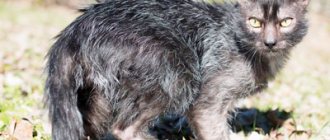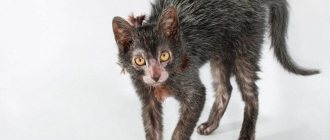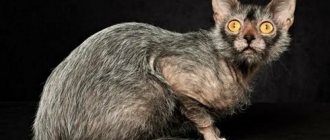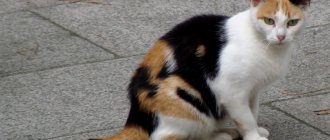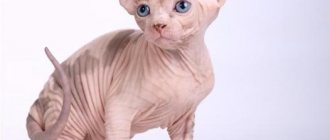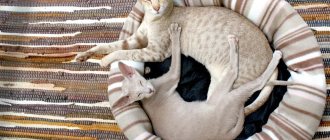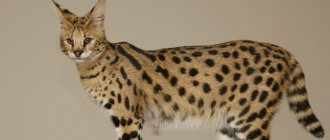Can an ordinary domestic cat combine the characteristics of a furry purr and a mythical creature? The answer to this strange question is clear – maybe! A striking example is the “werewolf” cat. This is not fiction, but a real attractive animal that knows how to be an affectionate and gentle animal.
The breed of "werewolf" cats is called the Lyka . If you literally translate the unusual Greek word “Lykoi”, you get “wolf”. When choosing a name for the new breed of werewolf cats, breeders sought to emphasize the unique and somewhat strange appearance. At the same time, the Lykoi cat remains a typical representative of its family, combining many diverse character traits.
Brief history of the breed
Lykoi cats were bred in 2010 in the US state of Virginia. The history of the breed began with the fact that an ordinary short-haired female gave birth to babies with partially missing fur. The owner of the kittens, Patti Thomas, saw in the peculiar appearance of the newborns a resemblance to characters from horror films and began to call them Lykoi.
To understand the heredity of the unusual offspring, the American woman turned to the breeder of Canadian Sphynx dogs, John Gobble, for advice. He studied the issue in detail and found out that two similar kittens were born in Tennessee. This information gave hope for the emergence of a new exotic breed.
Genetic studies have shown that all four kittens have the same recessive gene in which a mutation has occurred. Breeders managed to very quickly consolidate the characteristics characteristic of Lykoi. And as a result of a special program, in which both pairs of the first cats participated, in the fall of 2011, kittens of the second generation were born with the same characteristic appearance. In 2012, the breed was recognized by American and some world felinological organizations.
Health
Likoya can hardly be called a cute cat.
Maybe visually Liki seems not quite healthy, due to her strange appearance, but in reality this is not the case. The breed is surprisingly strong and resistant to all kinds of diseases. This fact has been confirmed by repeated genetic and veterinary studies. True, geneticists do not exclude the possibility of some hidden anomalies. So far, nothing has been revealed in this regard.
There is no exact information about the life expectancy of Lykoi, since the breed is new. Based on existing data, demon cats with proper care can easily live up to 15-16 years.
Interesting facts about werecats
Despite the fact that the Lykoi have a short history, a lot of interesting things have happened to them:
- The name of this cat breed comes from the Greek word lykoi, translated meaning “werewolves” or “werewolves”.
- Due to their unusual appearance, which gives these pets a resemblance to fantastic creatures, representatives of the breed are often called werewolves, Licon cats or devil cats.
- Before Lykoi were bred, their characteristic color was found only in horses.
- Genetic tests have shown that representatives of the breed do not have the gene for hairlessness, which is characteristic of representatives of hairless cat varieties. Based on this, it was concluded that the Lykoi are not related to the Sphinxes and Devons.
Purchasing a kitten
It is almost impossible to buy a Lykoi kitten, since due to its small numbers the breed is bred only in three registered nurseries. Two of them are located in the USA (Oklahoma and Michigan) and one in Russia (Murmulet elite cattery, Moscow). The future owner chooses the gender of the kitten according to his taste.
Kittens are offered for sale at the age of three months. Before this, the breeder gives the baby a primary vaccination and registers it with TICA, where he receives a metric guaranteeing the purity of the breed. Subsequently, the owner exchanges it for a pedigree. The cost of a roan kitten starts from 160,000 rubles, non-standard bicolor and blue kittens are not so spectacular, so they cost less - from 95,000 rubles.
Description of the breed standards, appearance of the Lykoi
Lykoi are harmoniously built, thin-legged cats with expressive eyes and uneven coat. A breed standard with a detailed description of these animals was developed in 2012.
Dimensions and weight
Lykoy cats are not heavyweight breeds. The average weight of an adult female is 3.5 kg. The weight of a male can reach 4.5 kg.
Anatomical characteristics
According to the TICA standard, Lykoi cats must meet the following description:
- The head is medium in size, wedge-shaped, with soft contours, a slightly elongated forehead, a bald muzzle and fleshy, smoothly outlined whisker pads. The cat's nose is rounded and slightly pointed downwards.
- The eyes are large, slanted, with an open, penetrating gaze. A cat's iris is yellow, green or blue-gray.
- The ears are large, set far apart, with a wide base and pointed tips.
- The body is flexible, slightly elongated, thin, with well-developed muscles.
- The limbs are thin, of medium length, with oval paws and a bare lower part.
- The tail is short, gradually tapering towards the tip.
We recommend the article – “Top Most Scary Cats“.
Color and coat type
Lykoi are covered with soft, loose fur that grows in tufts, the thickness of which depends on the time of year. Due to the lack of down and a very thinned spine, it seems that cats of this breed suffer from a dermatological disease. And the bald patches on the face form a kind of mask.
The coat color of cats of this breed in professional terminology is referred to as roan. Each hair has a light gray or white base and a black tip.
On a note. Lykoi kittens are born with black fur. The graying characteristic of the breed appears on their coats as they grow older.
Possible breed defects
Disadvantages, in the presence of which a wolf cat will not receive a high rating for its exterior:
- limbs completely covered with fur;
- absence of a bald mask on the face;
- all color options except roan.
Lykoi: pregnancy and childbirth
Since a minimum number of breeders are engaged in breeding the Likoi breed on the territory of the Russian Federation (remember: Likoi is not the most popular breed in our country, which also costs a lot of money), information on this issue had to be sought on foreign forums. The main summary looks like this:
- cats of the Lykoi breed remain pregnant for the same amount of time as ordinary short-haired cats, a little more than two months (63 - 72 days);
- The Likoevs have from 1 to 6 kittens in a litter. Moreover, all of them are reserved by buyers for several years in advance;
- Lykoi kittens are born with a small coat of hair, but soon this coat is shed, becoming similar to the Sphinx. After some time, the fur grows back.
Character and temperament of a werecat
Lykoi are endowed with a good-natured, flexible and sociable disposition. Cats of this breed quickly become attached to their owners, but are wary of strangers. Lykois have no problem remaining alone and do not become stressed from a long separation from their owner.
On a note. The specific nature of cats of this breed does not allow them to easily make contact with strangers. And if the Lykoi suspect a stranger of bad intentions, they will attack without hesitation.
Lykoy cats get along well with their relatives and with non-aggressive dogs. True, sometimes conflicts can arise between them. Due to their developed hunting instinct, Lykoi will not tolerate small rodents or birds near them. Therefore, having a hamster or parrot as a companion for a werecat is not the best idea.
Characteristics of the Likoy breed
global $ads_google;
//data-ad-slot=”2475549904″ $ads_google = empty($ads_google) ? false : true; ?> if ($ads_google == false) {?> $ads_google = true; ?> } ?> Representatives of the Likoy breed are distinguished not only by their unusual appearance, but also by their unique character. The transformation from an affectionate and exemplary cat can happen literally before your eyes. As soon as a stranger appears in the house, the werewolf cat becomes an ardent defender of its space. The care of the owner and family members is a priority for her.
Such wild notes of character can appear in a Lykoi cat in relation to other animals. Even large dogs are not an obstacle for them that they are afraid of. That is why everyone who dreams of a cat with a mythical appearance and has other four-legged animals in the house should think about the advisability of such a neighborhood.
But, despite this character trait, the Lykoi cat is very kind and devoted to its owners. Werewolf cats are not afraid of loneliness either. If, due to life circumstances, the owner needs to leave the house, his pet will find something to his liking. Therefore, for busy people, Lykoi is a great find.
Another positive feature of the Lykoi cat is its sharp intelligence. Even when playing with intellectual toys, these pets show intelligence and resourcefulness. They have this level of development by nature - true hunters must be not only dexterous, but also smart. It is because of their hunting nature that it is recommended to walk half-naked cats on a leash. This is a guarantee that the pet will not run away in the heat of the hunt.
How to choose the right kitten
Lykoi is a cat of a rare and small breed, so it is not so easy to buy one. There are only a few nurseries registered with TICA that specialize in breeding these animals, and all of them are located in the United States.
This means that you will have to negotiate with breeders to purchase a kitten resembling a werewolf over the phone, and choose your future pet in absentia.
Before you finally decide and conclude a deal, it is advisable to pay attention to the following nuances:
- availability of documents;
- compliance with breed standards;
- conditions of detention;
- behavioral characteristics;
- health status.
On a note. Little Lykoi differ from kittens of other breeds by the presence of a bald mask on the face and hairless areas on the paws.
Kitten care
Little Lykoi go to new homes no earlier than 12 weeks of age. At this point, kittens that look like a werewolf are already accustomed to solid food, a tray and a scratching post, and also have routine vaccinations. To make Lykoys feel comfortable with their new owners, they are given a cozy bed, bought several toys and given a few days to adapt.
To prevent the inquisitive werewolf cat from being injured, his access to electrical wires, detergents, ornamental plants, small objects, large household appliances, open balconies and windows is blocked.
Castration and sterilization
If you still managed to acquire such a rare pet as the Lykoi, then do not rush to sterilize it, because there are so few of them in nature that it would be better to continue breeding them. However, due to the presence of a unique appearance, which is a recessive trait, only representatives of the same breed are necessary, so if one is not found, the best solution would be to sterilize.
At what age is it recommended to have surgery?
Cats are spayed between 7 and 12 months of age. The exact period must be clarified during a consultation with a veterinarian. The operation is performed on cats between the ages of 10 months and 1.5–2 years. When choosing the moment for the operation, you need to pay attention to the fact that the younger the animal, the easier it will tolerate the procedure.
Caring for your pet after surgery
Regardless of gender, after sterilization you should:
- carefully transport an animal under anesthesia home;
- While the anesthesia wears off, put the pet in a warm place, but not close to the radiator;
- every half hour, put moisturizing drops into the eyes or open and close the eyelid;
- keep the animal under constant observation until the anesthesia wears off, since after waking up it is capable of causing injury to itself;
- After your pet wakes up, place a bowl of water and food in front of him.
Cats recover from surgery quite quickly, but in the case of a cat, you will need to take care of the suture and continue to monitor the animal’s behavior. What medications should be used to treat the wound should be checked with the doctor who operated on the cat, but a special blanket is put on all cats immediately after the operation. It should be worn for 3 days; it should be left for a longer period only for those animals that are actively trying to lick the wound even through it.
After surgery, the cat needs to be covered with a blanket to prevent it from licking the stitches.
Care and maintenance of werecats
Lykoi are unpretentious pets; they do not require special conditions. True, due to the partially absent coat, representatives of the breed must be protected from direct contact with ultraviolet radiation, because under the influence of sunlight, their bare skin temporarily becomes covered with dark spots or completely blackens. Otherwise, cat care comes down to simple hygienic procedures.
Hygiene procedures
In order for a cat with the appearance of a werewolf to have a neat appearance, she is provided with appropriate care:
- Lykoya's claws are shortened with a nail clipper as they grow. Moreover, only the transparent ends are cut off. To prevent a werewolf in cat skin from scratching the furniture upholstery, he is provided with a scratching post.
- Twice a week, Lykoyas brush their teeth with a soft brush and non-foaming paste. To prevent plaque and tartar, the werecat is offered special chewable treats.
- The ears and eyes of the Lykoi are regularly inspected for the presence of uncharacteristic discharge and gently wiped with cotton pads soaked in alcohol-free lotion or herbal decoction.
Grooming
Lykoi are partially hairless pets with hairless areas on their bodies. Hairless skin of cats sweats, so it is regularly wiped with wet wipes.
Shedding in representatives of this breed does not depend on the season, so they can change their coat several times throughout the year. To make a cat's ragged coat look well-groomed, it is brushed several times a week with a special brush. During the period of active molting, the procedure is carried out daily.
Tray
The cat of this breed is very clean and quickly gets used to relieving itself in a designated place. Until the little Likoi grows up, he is provided with a tray with low sides. And for adult cats, they buy a litter box whose dimensions correspond to their size. It is advisable to use wood or mineral granules as a filler for the Lykoya tray.
Care instructions
Lykoi can be compared to babies, because they require careful and regular care, but, alas, they cannot really take care of themselves.
Bathing
Their skin is similar to the skin of sphinxes: it also secretes a viscous secretion and “sweats.” If you don't wash it off, it starts to smell unpleasant and stain everything around you. Every month the cat needs to be bathed: in warm water, using a special mild detergent. Human gels and shampoos often cause diarrhea, rashes and irritation.
“Doctor ZOO”, “Clandestine”, Cliny “Deep Cleaning” have proven themselves well: these are soft budget products that wash away dirt well and remove unpleasant odors. Dry the cat with his personal soft towel, and then dry it with a hairdryer or near a radiator.
Lykoei skin quickly “burns” in the sun: literally an hour or two in the sun and hello, reddened and painful skin! Therefore, do not allow the animal to lie on the open balcony.
If you live above the first floor, install special strong nets on the windows. Likoy, in the excitement of the hunt, will easily jump out of the window. Imagine if this is the eighth floor?
They shed profusely and often, so be prepared for daily brushing and frequent cleaning of the house.
Claws
His claws are trimmed every week: they grow very quickly. This does not cancel the purchase of a quality scratching post.
Eyes
The ears and eyes are looked after like the rest. If the eyes do not “flow”, then there is no need to touch them. If you notice pus in the corners or the cornea turns red, take the animal to the veterinarian as quickly as possible. Wax from the ears is cleaned with a cotton pad soaked in chlorhexidine or a piece of soft cloth. No lotions or water should be poured inside: this will provoke severe internal inflammation of the ear!
Teeth
Teeth are brushed once a week if the cat eats dry food, and 2 times if he eats natural food with a sufficient amount of meat. Only special toothpaste is suitable: with glycerin, triphosphate or carrageen in the composition. Brush: a regular baby brush (with trimmed bristles), a finger brush, or a piece of gauze wrapped around your finger.
You need to get used to cleaning your face from an early age. If your pet is categorically against the procedure or you do not dare to brush his teeth yourself, contact a veterinary clinic. There they will perform mechanical (under local anesthesia and sedative) cleaning or laser cleaning (a more gentle, but also more expensive procedure).
Feeding the werecat
Due to increased heat exchange, Lykois should receive larger portions than cats of other breeds. It is important to maintain a balance so as not to overfeed your pet.
Complete diet
Professionals recommend giving lykoia high-quality premium or super-premium drying. When choosing food for representatives of the breed, it is advisable to pay attention to expiration dates and composition. It is important that the feed does not contain soy, corn, wheat and other unhealthy additives. The following brands of drying best fit these criteria:
- Royal Canin;
- Hills;
- Acana.
With a natural type of feeding, Lykoi should receive a sufficient amount of raw lean meat, ocean fish and offal. Also, the diet of werecats can be diversified with quail eggs, cereals, boiled vegetables and sour milk.
To maintain health, Lykoys are never given sausages, pickles, smoked meats, mushrooms, potatoes, pork, river fish, sweets, pastries or any food from the host’s plate.
Feeding frequency
The number of meals depends on the age of the werecat:
- up to 4 months – 6 times a day;
- 4-5 months – 5 times a day;
- 5-9 months – 4 times a day;
- 9-12 months – 3 times a day.
From the age of one year, Lykoi can get by with two feedings a day.
Vitamins and minerals
To prevent Lykoi from suffering from vitamin deficiency, special supplements are introduced into their diet twice a year. It is important that the selection of vitamin and mineral complexes occurs with the participation of a veterinarian familiar with the characteristics of a particular cat.
Raising and physical activity of a werecat
Lykoi are energetic cats with strong hunting instincts. Representatives of this breed love to walk on a leash and have fun with improvised toys.
To maintain good physical shape, the lykoyam is equipped with a corner with tunnels, ladders and multi-level platforms. And so that werecats have something to do in the absence of their owners, they buy several toys.
Lykoi are intellectually developed pets that quickly remember the rules of behavior in the house. Werecats easily get used to the litter box and scratching post and often surprise their owners with their resourcefulness.
Lykoi: food
Since the Lykoi's fur is sparse and grows with receding patches, this breed of cats has to eat much more for normal thermoregulation, which often leads to obesity. So from a young age, Lykoys are accustomed to three meals a day, preferably super-premium food (ideally holistic). Moreover, preferably the line of food that is aimed at cats without hair.
What are we going to cook today?
But it is very difficult to choose natural feeding for Likoev. And, if you happen to be the happy owner of this breed of cat and decide to feed it “naturally,” then be sure to consult with a zoo nutritionist. Most likely, in addition to food, the cat will need to be fed a vitamin complex. Factory feed, as you understand, already contains all the necessary vitamins and microelements.
Vaccinations and antiparasitic treatment
Lykoi are susceptible to standard feline infections, so they should be vaccinated as a preventive measure. The first vaccination against rhinotracheitis, calcivirosis and panleukopenia is given to kittens of this breed at 7-8 weeks.
After 28 days, little Lykoi are vaccinated with the same drug, but with an anti-rabies component. In the future, cats are vaccinated annually.
To prevent diseases transmitted by fleas and worms, representatives of this breed are regularly subjected to antiparasitic treatment. Anthelmintics are given to Lykoyas twice a year, repeated every 10-12 days. To combat fleas, werecats are treated with special drops or shampoos.
Pros and cons of the breed
Lykoi, like cats of any other breed, have their advantages and disadvantages:
| pros | Minuses |
| Extraordinary appearance | Rarity of the breed |
| Agreeableness | Developed hunting instinct |
| Good tolerance of loneliness |
Lykoi are extraordinary cats, they are very different from representatives of most other breeds and evoke conflicting emotions. But those who are able to see and appreciate their beauty will acquire a loyal and kind friend in their person.
Breeding Features
In order to start breeding Lykoi, you need to be a professional breeder and breeder. There are no more than a hundred Lykoi kittens in the world, half of them are of an unconventional blue color, the rest are roan.
For breeding, you will need two representatives of the Lykoi, which are difficult to obtain; breeding them is almost impossible for a beginner. With such a seemingly repulsive appearance, such kittens are in great demand from interested buyers.
They have practically no hair, but the cats are smart, loyal and easy to train.


